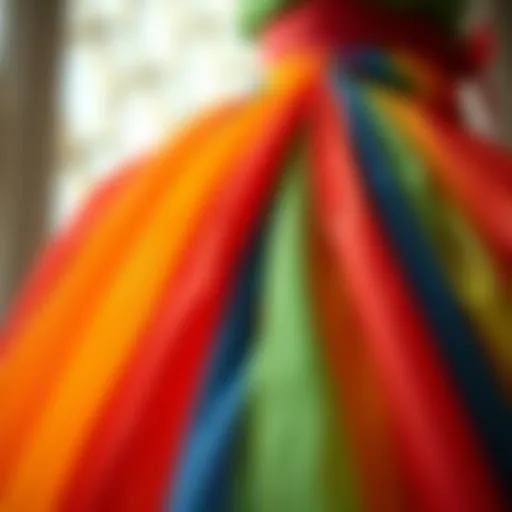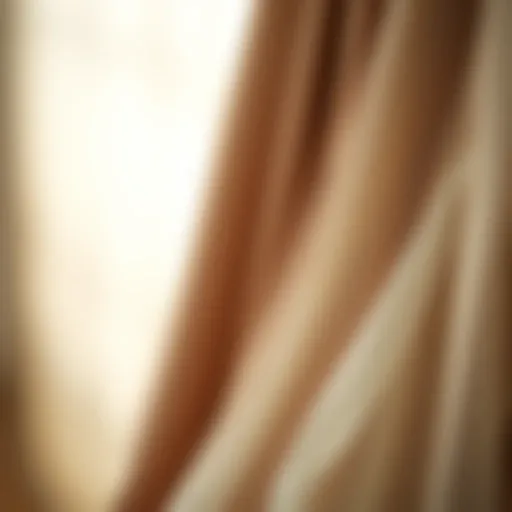Moisture Socks: A Solution for Dry Feet Relief
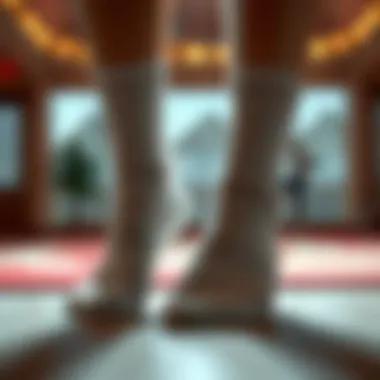

Intro
In the realm of personal care, often it’s the smaller items that can make a significant difference. Among these, moisture socks stand out as an essential addition for anyone struggling with dry feet. These specially designed garments aim to tackle the discomfort associated with dry or cracked skin, providing both hydration and protection. With their unique composition and thoughtful construction, moisture socks not only improve foot conditions but can also incorporate seamlessly into daily routines.
From the moment one slips into a pair of moisture socks, they might be surprised by the wave of relief that accompanies their wear. What you may not know is that these socks come with a variety of benefits and material choices that cater to different lifestyles. This article will demystify moisture socks, offering insights into their effectiveness and everyday application. By exploring user experiences, expert recommendations, and practical tips, we hope to present an informative guide to help you enhance your foot care regimen.
The desire for softer, hydrated feet is universal, and understanding how to achieve that is vital. Whether you’re an athlete constantly on the go or someone who simply wants to pamper their feet after a long day, the following sections will delve into the various aspects of moisture socks, highlighting their significance in foot health.
Fabric Knowledge
Types of Fabrics
When it comes to moisture socks, the fabric choice can profoundly influence their effectiveness. Let’s break down some commonly used materials:
- Cotton: While it’s a classic choice, cotton alone may not offer the moisture-wicking properties needed to keep feet dry. However, blended cotton can be effective when combined with synthetic fibers.
- Microfiber: Known for its softness and durability, microfiber excels at retaining moisture while allowing breathability. It's an excellent choice for daily wear.
- Bamboo: Increasingly popular, bamboo fabric is not only soft but has natural antibacterial properties. This makes it suitable for those prone to foot odor.
- Nylon/Spandex: These synthetic materials offer great elasticity and fit, often enhancing the moisture socks’ snugness. They are specifically designed to wick away sweat effectively.
How to Care for Different Fabrics
Caring for moisture socks properly ensures longevity and effectiveness. Here are some basic care tips divided by fabric type:
- Cotton: Can generally be machine washed in warm water, but best to avoid bleach. Air drying is recommended to maintain integrity.
- Microfiber: Typically requires gentle washing cycles. Avoid fabric softeners, as they may diminish water-wicking abilities.
- Bamboo: Follow washing guidelines carefully, often best washed in cold water and let air dry.
- Nylon/Spandex: Lasts longer when washed on a delicate cycle and not subjected to high heat.
Proper care is essential! Not maintaining your moisture socks can lead to a decline in their ability to retain moisture, negating their benefits.
User Experiences
The effectiveness of moisture socks often shines brighter through personal testimonies. Users frequently note significant improvements in skin texture and relief from discomfort, highlighting how these socks can embrace the feet in cozy hydration. From professional athletes who require maximum foot comfort to individuals seeking relief from daily stresses, the feedback has been overwhelmingly positive.
Benefits to Consider
- Enhanced Comfort: Many users report an immediate feeling of comfort, reducing instances of cracked heels.
- Ease of Use: Moisture socks can seamlessly integrate into both casual and formal settings.
- Affordability: Compared to other foot care products, moisture socks are generally priced reasonably, making them accessible.
Understanding the materials and benefits of moisture socks, alongside the care they require, can pave the way to healthier, happier feet. As we move towards style tips and how these socks fit into current fashion trends, the following sections will continue to inform and elevate your journey in foot care.
Preamble to Moisture Socks
Moisture socks are more than just a foot accessory; they play a significant role in combating the discomfort associated with dry feet. In a world where we spend so much time on our feet, it becomes crucial to maintain their health and comfort. This section explains why moisture socks deserve a place in every footwear arsenal, particularly for individuals struggling with dryness that can lead to cracks and other foot ailments. The benefits are not merely aesthetic; they encompass overall foot wellness.
Defining Moisture Socks
Moisture socks are specially designed to manage foot moisture and create an environment that promotes hydration. Unlike ordinary socks that merely cover the feet, these socks utilize innovative materials and construction techniques to wick away sweat and retain necessary moisture. They're tailored to address common complaints regarding dryness, making them a popular choice for those experiencing foot issues.
There are various types of moisture socks available, ranging from thin liners to thicker, cushioned options. Each type serves a unique purpose, whether that's providing a base layer for sports activities or cozy warmth during colder months. Regardless of the design, the key feature remains their ability to keep feet insulated while managing moisture levels effectively. Thus, one can see how important they are in countering the otherwise crippling effects of dryness.
Common Issues Related to Dry Feet
Dry feet can manifest in numerous ways. For starters, drying skin can lead to cracking that not only is unsightly but also painful. When skin becomes dry, it can lack the elasticity needed to stretch and move, causing discomfort and exacerbating the condition. Additionally, a common issue many overlook is the growth of bacteria and fungus that thrive in dry, cracked skin. This can lead to infections that require medical attention.
Another prevalent concern is the social embarrassment some individuals feel due to the appearance of their feet. Cracked heels or flaky skin can deter people from engaging in activities like swimming or even casual gatherings. They can often feel self-conscious, further intensifying the psychological impacts of dry feet.
However, moisture socks can mitigate these drawbacks effectively. By providing a breathable yet protective layer, they can minimize the risk of skin-related issues while offering comfort.
In summary, dealing with dry feet is not purely a cosmetic concern; it also influences physical health and emotional well-being. Transitioning to moisture socks could be the answer for many looking to enhance their daily comfort and foot health.
Material Composition of Moisture Socks
The material composition of moisture socks plays a crucial role in their effectiveness in combating dry feet. Understanding what goes into these socks helps individuals choose the most suitable product for their needs. The right materials not only enhance comfort but also facilitate better moisture management, ensuring feet remain hydrated. This section outlines various materials used in moisture socks, delving into their unique properties and benefits.
Synthetic Fibers
Synthetic fibers, such as nylon and polyester, offer many benefits when it comes to moisture socks. These materials are engineered to wick away moisture efficiently, allowing feet to breathe. One of the standout characteristics of synthetic fibers is their durability; they resist wear and tear, making them a cost-effective choice. However, they may not be as breathable as natural alternatives, which can lead to discomfort for some users if worn for extended periods.
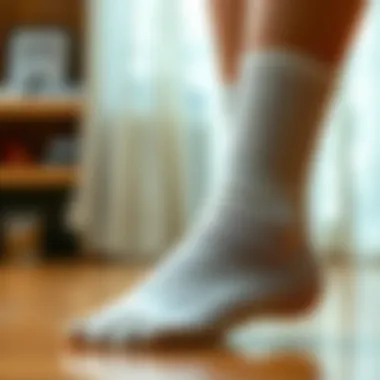

Often, synthetic fibers are blended with other materials to augment their moisture-wicking capabilities while retaining softness. This combination often balances the performance with comfort, ensuring that moisture socks remain functional without sacrificing wearability.
Natural Fibers
Natural fibers have their own set of advantages, particularly in the realm of moisture socks. They tend to provide a gentler touch against the skin and often retain more humidity, which can be beneficial in preventing dryness.
Cotton
Cotton is one of the most popular choices in moisture sock manufacturing due to its moisture-absorbing capabilities. A key characteristic of cotton is its softness, making it a comfortable option for all-day wear. Since cotton absorbs moisture rather than wicking it away, it's best suited for those who prefer a cushioned, cozy feel over hours of wear.
One unique feature of cotton is its hypoallergenic nature. This makes it an ideal material for people with sensitive skin or allergies. However, a notable disadvantage is its propensity to retain moisture, leading to potential dampness that can exacerbate dry skin if not managed carefully. Thus, while cotton provides comfort, it's vital to consider how it interacts with one's foot health in specific conditions.
Wool
Wool stands out in the realm of moisture management. Its unique structure enables it to wick moisture away from the skin while maintaining a warm temperature, making it a perfect choice for colder climates. The key characteristic of wool is its insulating properties while remaining breathable, which helps keep feet dry yet cozy.
Another significant advantage of wool is its natural antibacterial qualities. This reduces the chances of developing unpleasant odors, which is a common issue with longer wear. However, some individuals might find wool socks to be slightly itchy initially, which can deter them from choosing this material.
Specialized Moisture-Wicking Materials
In recent years, specialized moisture-wicking materials have emerged, designed specifically to tackle dry feet issues. These materials often feature complex fibers engineered to enhance moisture extraction and evaporation. They are typically lightweight, quick-drying, and breathable, promoting healthier feet throughout the day.
Using specialized materials can lead to an improved overall foot experience, particularly for those who engage in heavy physical activities or spend extended periods on their feet.
Ultimately, understanding the differences between these materials guides individuals to opt for moisture socks that best meet their lifestyle and foot health needs.
The Science Behind Moisture Management
Moisture management plays a pivotal role in maintaining not just the overall health of our feet but also the comfort of our daily activities. Understanding how moisture socks function in this regard offers insights into their contributions towards alleviating dry feet. When feet dry out, they can become cracked, painful, and even susceptible to infections. Moisture socks are designed to combat these issues through effective moisture retention and skin hydration.
How Moisture Socks Work
Moisture socks include technical materials that are engineered to wick moisture away from the feet and into the sock, rather than allowing it to accumulate. This unique mechanism helps keep the feet dry on the surface while simultaneously preventing excess moisture build-up that can lead to blisters or fungal infections. These materials work in tandem with your natural foot perspiration, creating a balance that maintains comfort.
For instance, when an individual engages in strenuous activities, their feet may perspire more than usual. Moisture socks, crafted from specialized synthetic fibers or moisture-wicking blends, act like a sponge, drawing moisture away from the skin. This process not only promotes a drier environment but aids in the steady hydration of the skin cells, providing a protective layer against the harshnesses of external conditions.
The Role of Hydration in Skin Health
Keeping the skin adequately hydrated is paramount to its overall health. Dehydrated skin may lead to a host of problems, including cracked skin and increased susceptibility to infections. Moisture socks enhance this hydration process significantly. They help preserve the natural moisture levels in the skin while allowing it to breathe.
The science behind hydration is simple: water content within the skin keeps it elastic and resilient. Moisture socks can act as a barrier, ensuring that essential moisture isn’t lost through evaporation, especially in dry environments. This is particularly important for individuals who work in arid workplaces, overuse their feet during athletic endeavors, or even tend to ignore foot care in their daily routines.
"Hydrated skin is like armor against external elements. Moisture socks become a vital tool in promoting this hydration, especially when lifestyle conditions might detract from it."
In summation, moisture management through the use of moisture socks is a vital component of foot wellness. Understanding the mechanisms at play and their beneficial impacts can aid in making more informed choices geared towards preventing dry feet and maintaining skin health.
Benefits of Using Moisture Socks
Moisture socks play a pivotal role in foot care, especially for those grappling with dry feet. These specially designed socks not only ease the discomfort associated with dry skin but also bring forth a suite of benefits that can enhance both foot health and overall comfort. When you dig deeper into why one should consider moisture socks, the reasons are compelling and worthy of exploration. Below are key benefits of using moisture socks that highlight their importance.
Prevention of Dry Skin
One of the premier benefits of moisture socks is their effectiveness in preventing dry skin. When feet remain trapped in ordinary socks, they don’t get the breathable environment needed to stay hydrated. Regular cotton or synthetic materials often absorb moisture, leaving the skin parched and vulnerable to cracking. Moisture socks, however, are crafted from specialized fibers that trap hydration and allow for optimal breathability, creating a climate that maintains skin moisture.
"Hydrated skin is happy skin. Moisture socks can turn a dry, uncomfortable experience into one of delight."
Furthermore, the design of moisture socks often incorporates moisture-locking properties, which help in retaining the skin's natural oils. This is beneficial for individuals living in arid climates or those who frequently engage in activities that cause sweating—a specific scenario where perspiration can lead to moisture loss in the feet.
Comfort and Enhanced Fit
Comfort is king when it comes to footwear, and moisture socks take it up a notch. The way these socks conform to the wearer’s feet ensures that they fit snugly without constricting movement. Unlike regular socks that might slip or bunch up, moisture socks are often designed with features that prevent slippage, providing a consistently comfortable wearing experience.
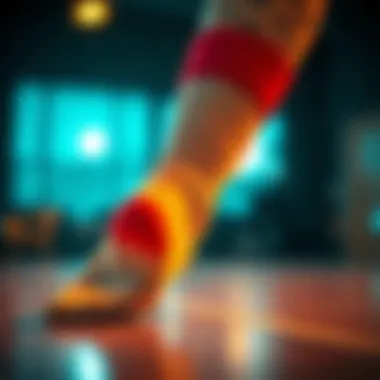

Reduced friction is another aspect where moisture socks shine. The materials used often have smooth textures that minimize irritation, much needed for those active on their feet. Whether you're hiking up a mountain or navigating through a busy office, moisture socks can make the day feel less burdensome.
Improved Skin Aesthetics
There’s more to moisture socks than just comfort; they actively aid in enhancing the appearance of the skin. Healthy, hydrated skin often looks more vibrant and youthful. Since moisture socks combat dryness and promote healing, regular use may lead to fewer visible cracks and dryness.
When your feet look good, it boosts confidence. Wearing moisture socks can help prevent the unsightly appearance of calluses and cracked heels, which often come from neglecting foot care. Well-maintained feet not only feel better but also look presentable, offering peace of mind in social situations.
In summary, the benefits of utilizing moisture socks extend far beyond mere comfort. They are essential tools in the fight against dry skin, offering a blend of prevention, comfort, and aesthetics. Understanding these advantages allows individuals to make informed choices about their foot care, paving the way for better foot health every day.
Who Can Benefit from Moisture Socks
Moisture socks aren't just a niche product; they serve a substantial purpose for a variety of individuals experiencing dry feet. Understanding who stands to gain the most from these specialized socks can equip users with better foot care strategies. Moisture socks' unique materials and designs offer targeted solutions to seemingly unrelated occupations, lifestyles, and health issues. Here are some specific groups that can greatly benefit from these socks:
Individuals with Chronic Dry Feet Issues
For those constantly battling dry skin, moisture socks can be a game changer. People suffering from conditions like eczema or psoriasis often find their feet peeling, cracking, or feeling incredibly uncomfortable. Standard socks lack the wattage for proper hydration. Moisture socks, on the other hand, function like a second skin by ensuring that the feet remain hydrated by wicking away nasty moisture and trapping in essential hydration. So, wearing these socks can help ease discomfort while promoting healthier skin. A user posted on reddit.com that using moisture socks reduced their foot dryness significantly after about a week of consistent use.
Athletes and Active Individuals
Athletes often stress their feet through rigorous training and competition. Sweat buildup is a common occurrence that can lead to an all-too-real risk of dry or cracked heels. Whether someone is a marathon runner or simply hitting the gym several times a week, moisture socks play a pivotal role in managing foot moisture. The specialized moisture-wicking materials help regulate temperature and whisk away sweat, keeping feet comfortable and less prone to dryness or irritation. Athletes have commented on platforms like facebook.com, expressing how incorporating moisture socks into their routine allows them to focus on performance rather than foot discomfort.
People with Occupations in Dry Environments
Occupational hazard isn't just about machines or weather; sometimes it involves the very climate we work in daily. For those employed in predominantly dry environments, such as warehouses or shops where heaters run continuously, the risk of dry skin escalates. Long hours in dry conditions can sap moisture faster than one can manage. For these individuals, moisture socks are beneficial because they can help maintain moisture levels throughout the day. Investing in quality moisture socks can provide a much-needed buffer against dryness, allowing workers to stay comfortable and focused. A worker once noted that since they began using these socks, they felt less irritation and discomfort at the end of long shifts.
"Moisture socks are a must-have for anyone living with dry feet. They can completely enhance your comfort levels, regardless of your lifestyle!" - Anonymous User
Choosing the Right Moisture Socks
Selecting the appropriate moisture socks can make a world of difference for those suffering from dry feet. These socks are not merely accessories; they hold the potential to transform the comfort and health of one’s feet. The right pair can significantly enhance moisture retention and overall foot well-being. When it comes to this subject, understanding the specifics of material choices and proper fit becomes crucial.
Evaluating Material Choices
When it comes to moisture socks, the material is foundational to their effectiveness. Different fabrics serve various functionalities aimed at moisture management. Here are some materials to consider:
- Synthetic Fibers: Fabrics like polyester and nylon offer excellent moisture-wicking properties. This means they pull moisture away from the skin, preventing dampness and discomfort. While they tend to dry quickly, synthetic options can trap heat, which might not be ideal for everyone.
- Natural Fibers: Cotton and wool are popular, each with unique characteristics. Cotton has profound absorbent qualities, suitable for moderate levels of moisture. However, it may not wick moisture as effectively as synthetics. Wool, on the other hand, can regulate temperature well and even maintains insulation capabilities when wet, making it a robust choice.
- Moisture-Wicking Materials: These fabrics often combine both synthetic and natural fibers to get the best of both worlds. Companies might create specialized fabrics designed specifically for retaining moisture and aiding in foot hydration. They often include additional treatments to improve their effectiveness against bacterial growth, thus helping combat odor, too.
Choosing the right material hinges on understanding your personal needs—how much moisture your feet typically produce, your activity level, and even the climate you often find yourself in.
Fit and Sizing Considerations
While the materials that make up moisture socks are of great importance, how those socks fit your feet can be just as crucial. Poorly fitting socks can lead to discomfort and even exacerbate foot issues.
- Sizing: Proper sizing is paramount. Socks that are too small may create unnecessary pressure points, leading to blisters, while those that are too large can bunch up, causing irritation. Consult the size chart of the specific brand to ensure you select the right fit.
- Arch Support: Some moisture socks come with added arch support which can enhance comfort for those who spend long hours on their feet. Without adequate support, one can encounter foot fatigue, which diminishes the benefits of moisture management.
- Length and Style: Consider the style of the sock as well. Ankle, crew, or knee-high options provide different levels of coverage. Choosing a longer sock may provide additional warmth and moisture control, while shorter versions can be more suitable for warmer weather.
"The right moisture socks are like a second skin; they should fit snugly without being constricting."
When it comes down to it, finding moisture socks that are both the right material and the right fit will greatly enhance their effectiveness. Taking the time to test different options is often worthwhile. Those with chronic moisture issues or individuals with heightened foot sensitivity should pay special attention to these elements.
Through careful selection, moisture socks can serve as a pivotal component in the daily ritual of foot care.
Best Practices for Using Moisture Socks
Wearing moisture socks can significantly alleviate dry feet, but adopting the right practices can enhance their effectiveness. Best practices encompass proper maintenance, pairing with the right products, and understanding when and how to wear these functional garments. For the discerning individual, it is paramount to blend comfort with efficacy to truly reap the benefits of moisture socks.
Regular Maintenance and Care
To ensure the longevity and performance of moisture socks, regular maintenance is essential. Proper care can extend their life, keeping them effective in moisture management.
- Washing: Always follow the care instructions on the label. Washing your socks in cold water is generally recommended. This helps preserve the integrity of moisture-wicking fibers.
- Drying: Instead of tossing them in a dryer, air drying is a wise choice. The heat can damage specialized materials. Laying them flat or hanging them up allows them to retain their shape.
- Storage: Keep your moisture socks in a cool, dry place. Avoid cramming them in tight spaces, which can lead to deformation.
Regularly checking for wear and tear is also important. If you notice any fraying or thinning areas, consider replacing your moisture socks. As the saying goes, "a penny saved is a penny earned," but this doesn’t apply to keeping worn-out garments that can be ineffective.
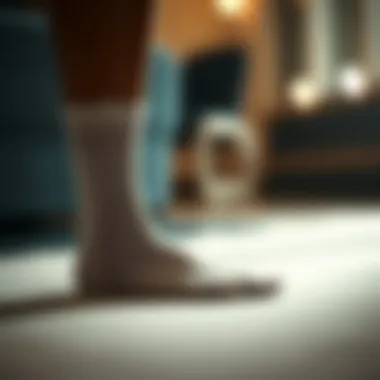

Pairing with Moisturizers
Moisture socks alone can address dry feet, but pairing them with moisturizers takes foot care to another level. Here’s how to maximize this combination:
- Choose the Right Moisturizer: Look for a thick cream or ointment designed specifically for feet. Ingredients like urea or shea butter offer deep hydration. Avoid products with a lot of fragrances as they can sometimes irritate sensitive skin.
- Application Method: Apply your moisturizer generously before slipping on your moisture socks. It works best when applied in the evening, allowing ample time for the product to absorb overnight. Think of it as a mini spa treatment for your feet while you sleep.
- Consistency Matters: Using this practice regularly helps maintain the elasticity and hydration of your feet. Incorporating this into your nightly routine ensures you’re not just maintaining moisture but actively revitalizing your skin.
"Caring for your feet isn't just about comfort; it’s about investing in your overall health."
Real User Experiences with Moisture Socks
Exploring real user experiences with moisture socks can open a window into how they truly function in everyday life. These anecdotal accounts provide insight into the practical benefits and sometimes unexpected results of using moisture socks. The voices of customers can be quite telling, shedding light not just on the socks themselves, but the overall effectiveness in overcoming dry feet issues. This section delves into personal stories and situations where moisture socks have made a difference, addressing their significance for people struggling with foot dryness, and how they fit into varied lifestyles and needs.
Testimonials from Regular Users
The stories from users who regularly incorporate moisture socks into their routines highlight a wide range of experiences. One user, Mia, a teacher who spends hours on her feet, shared that since she started wearing moisture socks, her evenings are not marked by the discomfort she previously experienced. "Before moisture socks, my feet felt like sandpaper after a long day. Now, it’s like I’m walking on clouds!" This sentiment resonates with many who find that moisture retardant materials help soothe and hydrate their skin.
Another user, Jamal, a runner, noted how warm and comfortable his feet felt during his long runs. He mentioned, "I used to have cracked heels after races. Switching to moisture socks not only kept my feet dry but also made me feel more confident in my stride." These testimonials indicate a common thread: moisture socks not only alleviate dryness but also improve overall foot comfort during various activities.
"Moisture socks turned my cracked feet into a memory. It’s all about how they manage moisture on long days!"
— Tasha, Spa Consultant
Effectiveness in Different Conditions
The effectiveness of moisture socks can vary widely based on conditions. For instance, users in humid climates might experience a different outcome than those living in arid regions. In humid areas, such as Miami, users have found the socks beneficial in reducing excessive moisture buildup, which can lead to blistering. Conversely, individuals in drier climates, like Denver, often highlight how moisture socks prevent the harsh, dry skin conditions that come from the environmental climate.
Here’s how moisture socks perform across various conditions:
- In High Humidity:
- In Arid Conditions:
- Pros: Help prevent blisters and excessive moisture.
- Cons: Some users feel dampness after wearing them for extended periods.
- Pros: Lock in hydration and reduce cracking.
- Cons: If worn too long without care, they may cause some moisture loss.
Individuals in professions requiring prolonged standing or those frequently on the move can especially benefit from moisture socks, as they adapt well to foot movement and temperature changes. Overall, user experiences illustrate that, regardless of the environment, moisture socks can serve as a practical remedy against dry feet, provided they are matched correctly to one’s lifestyle and climate.
Expert Opinions on Moisture Socks
Gaining insights from experts in dermatology and foot care is crucial in understanding the effectiveness of moisture socks in alleviating dry feet. These seasoned professionals bring invaluable knowledge drawn from years of research and clinical observations. By exploring their insights, we can better appreciate how moisture socks work and the specific benefits they offer to individuals facing issues related to dry or cracked feet.
Insights from Dermatologists
Dermatologists frequently emphasize the necessity of maintaining skin hydration, particularly for feet, often overlooked in skincare routines. According to Dr. Sarah Johnson, a dermatologist specializing in skin care, moisture socks can play an essential role in preventing the discomfort associated with dry skin. She explains, "When skin lacks moisture, it becomes rough and prone to cracking. Moisture socks can create a microclimate that helps retain moisture, which is beneficial for overall skin health."
- Hydration is Key: Regular application of moisturizers alongside the use of moisture socks may lead to improved skin elasticity and appearance. Dermatologists often recommend applying a thick cream or ointment before wearing moisture socks to enhance the hydrating effect.
- Reducing Irritation: For those suffering from conditions such as eczema or psoriasis on their feet, moisture socks help minimize irritation. The soft materials provide a barrier against rough surfaces, reducing friction and potential skin damage.
- Prevention of Infections: Maintaining moisture in the skin creates an environment that deters fungal infections, a common issue associated with dry feet. A moist environment, when managed correctly, can help keep the skin healthy and infection-free.
Advice from Footcare Specialists
Footcare specialists are on the front lines and see firsthand the consequences of neglect in foot hygiene. They often recommend moisture socks for anyone experiencing symptoms of dryness. Dr. Mark Ellis, a podiatrist with over 15 years of experience, provided some practical advice on the integration of moisture socks into daily routines.
- Choosing the Right Pair: The material matters significantly. Dr. Ellis states, "Opt for socks made with materials designed to wick moisture away from the skin while simultaneously locking in hydration. Avoid cotton for everyday use; rather go for blends that include bamboo or specialized polyester."
- Timing is Everything: It's beneficial to wear moisture socks overnight, especially after a foot-care regimen that involves exfoliation and moisturizing. This approach not only maximizes the regeneration process but also allows the skin to absorb the beneficial properties of topical products deeply.
- Regular Foot Assessments: Footcare specialists insist on conducting routine checks for any changes in skin condition. Early detection of any issues can be vital in preventing serious health concerns.
"Incorporating moisture socks into your routine can transform foot health, acting as a bridge between hydration and prevention," advises Dr. Ellis, highlighting their importance in both everyday foot care and medical treatment.
In summary, tapping into the expertise of dermatologists and footcare specialists sheds light on the value of moisture socks. They not only serve as a protective layer but also as a crucial tool for anyone looking to nourish and maintain the health of their feet.
Closure and Recommendations
Moisture socks stand as a remarkable solution for individuals plagued with dry feet. As we draw the curtains on our exploration of this topic, it's vital to recognize the pivotal role moisture socks play in enhancing foot health. Their significance extends beyond mere comfort; they can be crucial in alleviating the discomfort associated with dryness and cracked skin.
Summarizing the Importance of Moisture Socks
Moisture socks are much more than a fashion statement; they offer tangible benefits that can significantly improve one’s quality of life. First and foremost, their ability to regulate moisture levels ensures that feet remain hydrated, preventing the itchiness and chapping often linked with dry skin. Furthermore, a good pair of moisture socks can enhance daily activities, especially for those constantly on their feet or engaging in sports. By providing cushioning and support, these socks not only mitigate discomfort but also contribute to overall foot health. In essence, moisture socks can be viewed as a proactive measure. Instead of waiting for issues to arise, investing in moisture socks is a step towards preventing problems before they occur.
Future of Moisture Management in Footwear
Looking ahead, the future of moisture management in footwear appears promising. Innovations in textile technology are paving the way for even more effective moisture-wicking materials. Brands are already experimenting with blends of synthetic and natural fibers that promise superior breathability and comfort. One exciting area is the potential integration of biotechnologies that enhance skin hydration at a molecular level. As awareness around foot health continues to grow, we can expect a broader acceptance of moisture socks not just in specialized categories but in everyday fashion. In a world where self-care is paramount, embracing moisture management is no longer a luxury but a necessity.
"As we continue to innovate and improve comfort, the gap between need and fashion will blur, allowing moisture socks to be a staple in every wardrobe."
To summarize, moisture socks are an essential investment for maintaining foot health, with a bright future ahead as innovations unfold. For those struggling with dry feet, it’s high time to consider making these socks a part of your routine. In doing so, you enhance not only your foot health but also your overall everyday comfort.







